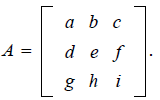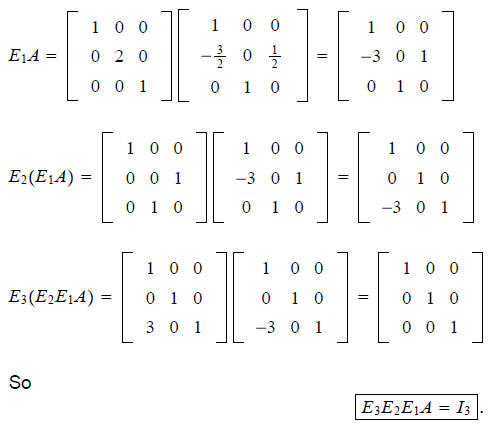Matrix Operations
THEOREM 2
Let A be m × n and let B and C have sizes for which the
indicated sums and products are
defined.
a. A(BC) = (AB) C (associative law of
multiplication)
b. A (B + C) = AB + AC (left - distributive law)
c. (B + C)A = BA + CA (right-distributive law)
d. r(AB) = (rA)B = A (rB)
for any scalar r
e.
 (identity for matrix multiplication)
(identity for matrix multiplication)
WARNINGS
Properties above are analogous to properties of real numbers. But NOT ALL real
number
properties correspond to matrix properties.
1. It is not the case that AB always equal BA. (see
Example 7, page 114)
2. Even if AB = AC, then B may not equal C. (see Exercise 10, page 116)
3. It is possible for AB = 0 even if A ≠ 0 and B ≠ 0. (see Exercise 12, page
116)
Powers of A

EXAMPLE.

If A is m × n, the transpose of A is the n × m matrix,
denoted by AT, whose columns are formed
from the corresponding rows of A.
EXAMPLE.

EXAMPLE: Let
 Compute AB,
(AB)T, ATBT and BTAT.
Compute AB,
(AB)T, ATBT and BTAT.
Solution.

THEOREM 3
Let A and B denote matrices whose sizes are appropriate for the following sums
and
products.
a. (AT) T =
A (I.e., the transpose of AT is A)
b. (A + B)T =
AT BT
c. For any scalar r, (rA)T =
rAT
d. (AB)T =
BTAT (I.e. the transpose of a product of matrices equals the product of their
transposes in reverse order. )
EXAMPLE. Prove that (ABC)T_________.
Solution. By Theorem 3d,

2.2 The Inverse of a Matrix
The inverse of a real number a is denoted by a -1. For example,
 and
and

An n × n matrix A is said to be invertible if there is an n × n matrix C satisfying
CA = AC = In
where In is the n × n identity matrix. We call C the inverse of A .
FACT If A is invertible, then the inverse is unique.
Proof. Assume B and C are both inverses of A. Then
B = BI = B (_____) = ( ______) ______ = I______ = C.
So the inverse is unique since any two inverses coincide.
The inverse of A is usually denoted by A -1.
We have
| AA -1 = A -1A = In |
Not all n × n matrices are invertible. A matrix which is not invertible is
sometimes called a
singular matrix. An invertible matrix is called nonsingular matrix.
Theorem 4
Let
 If ad
- bc ≠ 0, then A is invertible and
If ad
- bc ≠ 0, then A is invertible and

If ad - bc = 0, then A is not invertible.
Assume A is any invertible matrix and we wish to solve Ax = b. Then
_____Ax= _____b and so
Ix= _______ or x= _______.
Suppose w is also a solution to Ax = b. Then Aw = b and
_____Aw = _____b which means w = A-1b.
So, w = A-1b, which is in fact the same solution.
We have proved the following result.
Theorem 5
If A is an invertible n × n matrix, then for each b in Rn, the equation Ax = b has
the unique
solution x = A-1b.
EXAMPLE. Use the inverse of A

Solution. Matrix form of the linear system.


Theorem 6 Suppose A and B are invertible. Then the
following results hold.
a. A -1 is invertible and (A-1)-1 =
A (i.e. A is the inverse of A-1).
b. AB is invertible and (AB)-1 =
B-1A-1
c. AT is invertible and (AT)-1 = (A-1)T
Partial proof of part b.

Similarly, one can show that (B-1A-1)(AB) = I.
Theorem 6, part b can be generalized to three or
more invertible matrices.
(ABC)-1=
__________
Earlier, we saw a formula for finding the inverse of a 2 × 2 invertible matrix.
How do we find the
inverse of an invertible n × n matrix? To answer this question, we first look at
elementary
matrices.
Elementary Matrices
Definition
An elementary matrix is one that is obtained by performing a single elementary
row
operation on an identity matrix.
EXAMPLE. Let

and

E1, E2, and E3 are elementary matrices. Why?
Observe the following products and describe how these products can be obtained
by elementary
row operations on A.

If an elementary row operation is performed on an m × n matrix A, the resulting
matrix can be
written as EA, where the m × m matrix E is created by performing the same row
operations on Im.
Elementary matrices are invertible because row operations are reversible. To
determine the
inverse of an elementary matrix E, determine the elementary row operation needed
to transform
E back into I and apply this operation to I to find the inverse.
For example,

Example. Let
 . Then
. Then

Then multiplying on the right by A-1, we get
E3E2E1A______= I3______.
So
E3E2E1I3 = A-1
The elementary row operations that row reduce A to In are the same elementary
row
operations that transform In into A-1.


